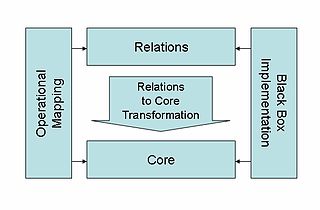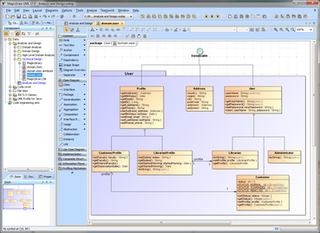Related Research Articles

The unified modeling language (UML) is a general-purpose visual modeling language that is intended to provide a standard way to visualize the design of a system.
The XML Metadata Interchange (XMI) is an Object Management Group (OMG) standard for exchanging metadata information via Extensible Markup Language (XML).

The Meta-Object Facility (MOF) is an Object Management Group (OMG) standard for model-driven engineering. Its purpose is to provide a type system for entities in the CORBA architecture and a set of interfaces through which those types can be created and manipulated. MOF may be used for domain-driven software design and object-oriented modelling.
A platform-independent model (PIM) in software engineering is a model of a software system or business system that is independent of the specific technological platform used to implement it.
A platform-specific model is a model of a software or business system that is linked to a specific technological platform. Platform-specific models are indispensable for the actual implementation of a system.
The Object Constraint Language (OCL) is a declarative language describing rules applying to Unified Modeling Language (UML) models developed at IBM and is now part of the UML standard. Initially, OCL was merely a formal specification language extension for UML. OCL may now be used with any Meta-Object Facility (MOF) Object Management Group (OMG) meta-model, including UML. The Object Constraint Language is a precise text language that provides constraint and object query expressions on any MOF model or meta-model that cannot otherwise be expressed by diagrammatic notation. OCL is a key component of the new OMG standard recommendation for transforming models, the Queries/Views/Transformations (QVT) specification.
Round-trip engineering (RTE) in the context of model-driven architecture is a functionality of software development tools that synchronizes two or more related software artifacts, such as, source code, models, configuration files, documentation, etc. between each other. The need for round-trip engineering arises when the same information is present in multiple artifacts and when an inconsistency may arise in case some artifacts are updated. For example, some piece of information was added to/changed in only one artifact and, as a result, it became missing in/inconsistent with the other artifacts.
The common warehouse metamodel (CWM) defines a specification for modeling metadata for relational, non-relational, multi-dimensional, and most other objects found in a data warehousing environment. The specification is released and owned by the Object Management Group, which also claims a trademark in the use of "CWM".

A metamodel is a model of a model, and metamodeling is the process of generating such metamodels. Thus metamodeling or meta-modeling is the analysis, construction and development of the frames, rules, constraints, models and theories applicable and useful for modeling a predefined class of problems. As its name implies, this concept applies the notions of meta- and modeling in software engineering and systems engineering. Metamodels are of many types and have diverse applications.
Model-driven engineering (MDE) is a software development methodology that focuses on creating and exploiting domain models, which are conceptual models of all the topics related to a specific problem. Hence, it highlights and aims at abstract representations of the knowledge and activities that govern a particular application domain, rather than the computing concepts.

ATL is a model transformation language and toolkit developed and maintained by OBEO and AtlanMod. It was initiated by the AtlanMod team. In the field of Model-Driven Engineering (MDE), ATL provides ways to produce a set of target models from a set of source models.

QVT (Query/View/Transformation) is a standard set of languages for model transformation defined by the Object Management Group.
A model transformation language in systems and software engineering is a language intended specifically for model transformation.
Executable UML is both a software development method and a highly abstract software language. It was described for the first time in 2002 in the book "Executable UML: A Foundation for Model-Driven Architecture". The language "combines a subset of the UML graphical notation with executable semantics and timing rules." The Executable UML method is the successor to the Shlaer–Mellor method.

MagicDraw is a proprietary visual UML, SysML, BPMN, and UPDM modeling tool with team collaboration support.
Knowledge Discovery Metamodel (KDM) is a publicly available specification from the Object Management Group (OMG). KDM is a common intermediate representation for existing software systems and their operating environments, that defines common metadata required for deep semantic integration of Application Lifecycle Management tools. KDM was designed as the OMG's foundation for software modernization, IT portfolio management and software assurance. KDM uses OMG's Meta-Object Facility to define an XMI interchange format between tools that work with existing software as well as an abstract interface (API) for the next-generation assurance and modernization tools. KDM standardizes existing approaches to knowledge discovery in software engineering artifacts, also known as software mining.
Architecture-driven modernization in computing and computer science, is the name of the initiative of the Object Management Group related to building and promoting standards that can be applied to modernize legacy systems. The objective of this initiative is to provide standard representations of views of existing systems, in order to enable common modernization activities, such as code analysis and comprehension, and software transformation.
The Semantics of Business Vocabulary and Business Rules (SBVR) is an adopted standard of the Object Management Group (OMG) intended to be the basis for formal and detailed natural language declarative description of a complex entity, such as a business. SBVR is intended to formalize complex compliance rules, such as operational rules for an enterprise, security policy, standard compliance, or regulatory compliance rules. Such formal vocabularies and rules can be interpreted and used by computer systems. SBVR is an integral part of the OMG's model-driven architecture (MDA).
MOF Model to Text Transformation Language is an Object Management Group (OMG) specification for a model transformation language. Specifically, it can be used to express transformations which transform a model into text (M2T), for example a platform-specific model into source code or documentation. MOFM2T is one part of OMG's Model-driven architecture (MDA) and reuses many concepts of MOF, OMG's metamodeling architecture. Whereas MOFM2T is used for expressing M2T transformations, OMG's QVT is used for expressing M2M transformations.
References
- ↑ "OMG pursues new strategic direction to build on success of past efforts" Archived 2006-09-24 at the Wayback Machine
- ↑ "OMG MDA Guide rev. 2.0". OMG | Object Management Group. The Object Management Group. Retrieved 4 September 2021.
- ↑ "OMG Trademarks | Object Management Group".
- ↑ adm website http://adm.omg.org
- ↑ Bézivin, J; Gérard, S; Muller, P-A; Rioux, L (2003). "MDA components: Challenges and Opportunities" (PDF). In: Metamodelling for MDA. Archived from the original (PDF) on 2006-12-06.
- ↑ "Hype Cycle for Emerging Technologies, 2006" $495.00
- ↑ "MDA Is DOA, Partly Thanks To SOA" Archived 2007-10-13 at the Wayback Machine
- ↑ "UML - Unified or Universal Modeling Language? UML2, OCL, MOF, EDOC - The Emperor Has Too Many Clothes"
- ↑ "MDA: Nice Idea. Shame about the..."
- ↑ "Bringing MDA to Eclipse, using a pragmatic approach"
- ↑ "A Response to Forrester"
- ↑ "Are You Ready For the MDA?"
- ↑ "The Rise and Fall of CORBA" Archived 2008-12-02 at the Wayback Machine
- ↑ "Avoiding Another Green Elephant"
